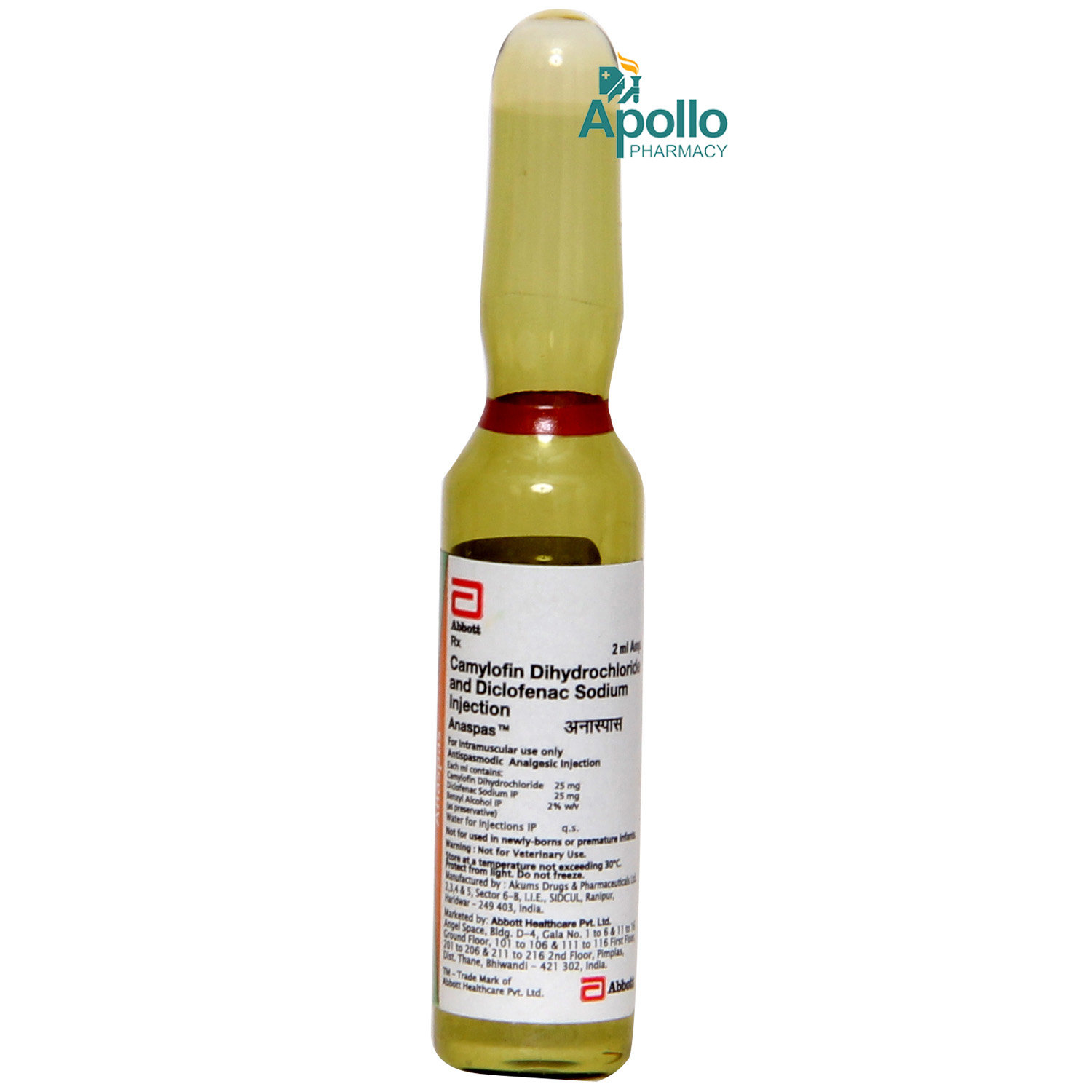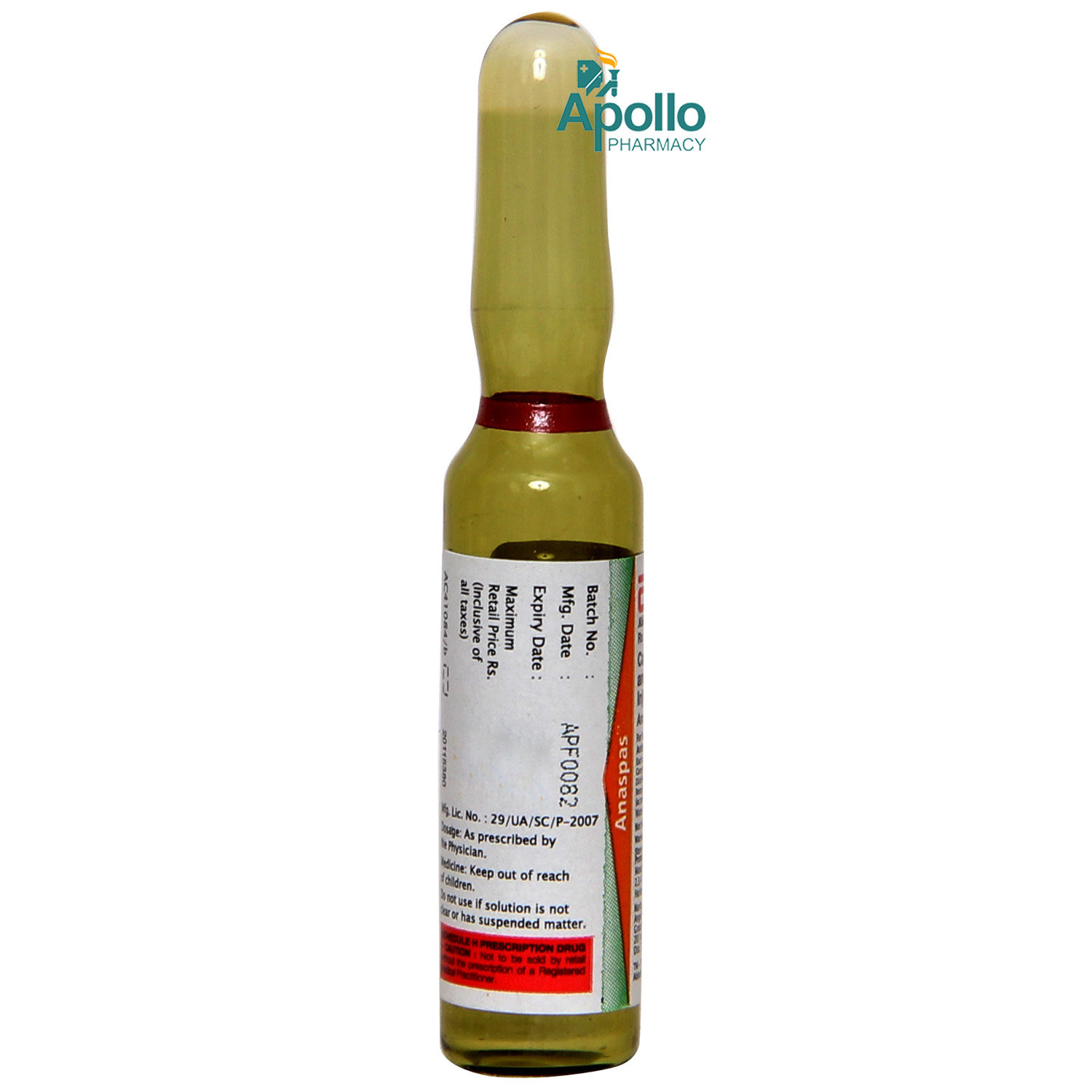Anaspas Injection 2 ml




MRP ₹43
(Inclusive of all Taxes)
₹6.5 Cashback (15%)
Provide Delivery Location
Online payment accepted
 Prescription drug
Prescription drugWhats That
Composition :
Manufacturer/Marketer :
Consume Type :
Return Policy :
Expires on or after :
About Anaspas Injection 2 ml
Anaspas Injection 2 ml belongs to the class of medications called ‘analgesics’. It is used to treat abdominal cramps or pain associated with various gastrointestinal conditions such as intestinal colic (blockage in the intestine), biliary colic (gallstones), renal colic (kidney stones), dysmenorrhea (menstrual cramps), and pancreatitis (inflammation of the pancreas), etc.
Anaspas Injection 2 ml is a combination of Diclofenac and Camylofin. Diclofenac is a nonsteroidal anti-inflammatory drug (NSAID) which works by reducing prostaglandins' production (chemical substances that cause pain and inflammation) at the affected site (muscle), and thus, it reduces pain. Camylofin is an antispasmodic drug. It relaxes the stomach and gut (intestine) and stops sudden muscle contractions (spasms).
Anaspas Injection 2 ml will be administered by a trained healthcare professional. Do not self-administer. Anaspas Injection 2 ml may cause certain common side effects such as stomach pain, heartburn, diarrhoea, nausea, vomiting, indigestion, loss of appetite, headache, dizziness, and injection site redness or rash. These side effects are usually temporary and resolve over time. However, if any of these side effects persist or get worse, inform your doctor immediately.
Anaspas Injection 2 ml should be avoided if you are allergic to it. Before starting treatment with Anaspas Injection 2 ml, inform your doctor if you have any bleeding or ulcer in the stomach, history of stomach or bowel problems due to using NSAIDs, severe liver, kidney, or heart failure, history of heart attack or stroke, problems with blood circulation, glaucoma (increased pressure in the eye), mechanical bowel obstruction, and prostate gland enlargement. This medicine is not recommended for use in children, pregnant women, and breastfeeding mothers as the safety and efficacy are not established. Anaspas Injection 2 ml should be used with caution in elderly patients. Avoid the consumption of alcohol as it may increase the risk of side effects. Anaspas Injection 2 ml may occasionally cause dizziness or vision problems, so do not drive or operate heavy machinery after receiving Anaspas Injection 2 ml.
Uses of Anaspas Injection 2 ml
Directions for Use
Medicinal Benefits
Anaspas Injection 2 ml is used to provide symptomatic relief or treat abdominal cramps in various conditions such as intestinal colic (blockage in the intestine), biliary colic (gallstones), renal colic (kidney stones), dysmenorrhea (menstrual cramps), and pancreatitis (inflammation of the pancreas), etc. Anaspas Injection 2 ml is a combination of two drugs: diclofenac and camylofin. Diclofenac can reduce pain, swelling, and inflammation, whereas camylofin can reduce spasms or sudden contractions by relaxing the smooth muscles. It is usually well-tolerated when used at recommended doses.
Storage
Drug Warnings
Before receiving Anaspas Injection 2 ml, inform your doctor if you have any bowel disorders such as colitis (inflammation of the intestine), kidney or liver problems, porphyria (inherited blood disorder), bleeding disorders, asthma, chronic obstructive pulmonary disease (obstruction in the airflow), seasonal allergies, long-term respiratory infections or illnesses, fever, angina (chest pain), blood clots, high blood pressure, high cholesterol, diabetes, systemic lupus erythematosus (a skin disorder), thyrotoxicosis (excess thyroid hormone secretions), smoking habit, and intolerance to some sugars. Anaspas Injection 2 ml increases the risk of heart attack or stroke if high doses are used for prolonged periods. So, use it in the dose and duration prescribed by the doctor. If you notice chest pain, breathing difficulties, weakness, or slurry speech, inform your doctor immediately, as it can be a sign of problems with the heart or blood vessels. Anaspas Injection 2 ml is an anti-inflammatory and can mask the symptoms of an infection, so consult your doctor if you feel unwell. Anaspas Injection 2 ml should be used with caution in patients undergoing heart surgery.
Drug-Drug Interactions
Drug-Drug Interactions
Login/Sign Up
Co-administration of Anaspas Injection 2 ml with Meloxicam can increase the risk or severity of gastrointestinal side effects.
How to manage the interaction:
Taking Meloxicam with Anaspas Injection 2 ml is not recommended as it can possibly result in an interaction, it can be taken if your doctor has advised it. However, consult your doctor immediately if you experience symptoms such as dizziness, lightheadedness, red or black, tarry stools, coughing up or vomiting fresh or dried blood that looks like coffee grounds, severe headache, and weakness. Do not stop any medication without doctor's advise.
Taking Anaspas Injection 2 ml with Enoxaparin can increase the risk of bleeding complications.
How to manage the interaction:
There may be a possible interaction between Anaspas Injection 2 ml and Enoxaparin, but they can be taken together if your doctor has prescribed them. However, consult your doctor immediately if you experience any unusual bleeding or bruising, swelling, vomiting, blood in your urine or stools, headache, dizziness, or weakness. Do not discontinue any medications without consulting a doctor.
Coadministration of Anaspas Injection 2 ml with Ketoconazole may increase the risk of liver problems.
How to manage the interaction:
There may be a possible interaction between Anaspas Injection 2 ml and Ketoconazole, but they can be taken together if a doctor has prescribed them. However, consult a doctor immediately if you have fever, chills, joint pain or swelling, unusual bleeding or bruising, skin rash, itching, loss of appetite, fatigue, nausea, vomiting, abdominal pain, dark colored urine, light colored stools, and/or yellowing of the skin or eyes. Do not discontinue any medications without consulting a doctor.
Taking Anaspas Injection 2 ml with human immunoglobulin may increase the risk of kidney problems.
How to manage the interaction:
Although there is an interaction between Human immunoglobulin and Anaspas Injection 2 ml, you can take these medicines together if prescribed by a doctor. However, consult the doctor immediately if you experience symptoms such as nausea, vomiting, loss of appetite, increased or decreased urination, sudden weight gain or weight loss, fluid retention, swelling, shortness of breath, muscle cramps, tiredness, weakness, dizziness, confusion, and irregular heart rhythm. Do not discontinue any medications without consulting a doctor.
Taking Anaspas Injection 2 ml with Ibrutinib can increase the risk of bleeding tendencies.
How to manage the interaction:
There may be a possible interaction between Anaspas Injection 2 ml and Ibrutinib, but they can be taken together if a doctor has prescribed them. However, consult a doctor immediately if you experience any unusual bleeding, dizziness, lightheadedness, red or black, tarry stools, coughing up or vomiting fresh or dried blood that looks like coffee grounds, or severe headaches. Do not discontinue any medications without consulting a doctor.
Co-administration of Anaspas Injection 2 ml with Celecoxib may increase the risk of stomach bleeding and ulcers.
How to manage the interaction:
Although there is a interaction between Anaspas Injection 2 ml and Celecoxib, but it can be taken if your doctor has advised it. Consult a doctor if you experience symptoms like blood in your urine or stool (or a black stool), severe bruising, prolonged nosebleeds, feeling dizzy or lightheaded, weakness or severe headache, vomiting blood or coughing up blood, heavy menstrual bleeding (in women), difficulty breathing, or chest pain. Do not discontinue any medication without consulting a doctor.
Co administration of Anaspas Injection 2 ml with Leflunomide may result in liver problems.
How to manage the interaction:
Co-administration of Anaspas Injection 2 ml and Leflunomide can lead to an interaction; it can be taken if advised by your doctor. However, if you have a fever, chills, joint pain or swelling, unusual bleeding or bruising, skin rash, itching, loss of appetite, fatigue, nausea, vomiting, abdominal pain, dark-colored urine, light-colored stools, or yellowing of the skin or eyes. Do not stop using any medication without consulting your doctor.
Concomitant administration of Anaspas Injection 2 ml and furosemide may decrease the therapeutic efficacy of furosemide and adversely affect renal function.
How to manage the interaction:
There may be a possible interaction between Anaspas Injection 2 ml and furosemide, but they can be taken together if your doctor has prescribed them. However, consult your doctor immediately if you experience symptoms like nausea, dizziness, irregular heartbeats, altered blood pressure, tingling. Do not stop using any medications without first talking to your doctor.
Co-administration of Anaspas Injection 2 ml and tenofovir alafenamide may cause kidney problems.
How to manage the interaction:
There may be a possible interaction between Anaspas Injection 2 ml and Tenofovir alafenamide but they can be taken together if your doctor has prescribed them. However, consult your doctor immediately if you experience symptoms such as such as nausea, vomiting, loss of appetite, increased or decreased urination, sudden weight gain or weight loss, fluid retention, swelling, shortness of breath, bone pain, muscle cramps, tiredness, weakness, dizziness, confusion, and irregular heart rhythm. Do not stop using any medications without talking to your doctor.
Taking Dasatinib together with Anaspas Injection 2 ml may increase the risk of bleeding.
How to manage the interaction:
There may be a possible interaction between Anaspas Injection 2 ml and Dasatinib but they can be taken together if a doctor has prescribed them. However, consult a doctor immediately if you experience dizziness, red or black, tarry stools, or severe headaches. Do not discontinue any medications without consulting a doctor.
Drug-Food Interactions
Drug-Food Interactions
Login/Sign Up
Diet & Lifestyle Advise
- Include more glucosamine, chondroitin sulfate, Vitamin D, and calcium-enriched supplements. Besides this, turmeric and fish oils can help in reducing pain and inflammation in the tissue.
- Please do not go for heavy exercise as it may increase abdominal pain. Instead, you can do stretching, low-impact aerobic exercise (like walking on the treadmill, bike riding, and swimming), and simple forms of yoga. You can also strengthen your muscle strength by lifting light weights and doing muscle stretching regularly.
- Your sitting posture is important, especially when you have pain and inflammation condition. Try to sit as little as possible and only for a short time (10-15 min). Use back support like a rolled-up towel to minimise pain at the back of your curve. Keep your knees and hips at a right angle.
- You can consume caffeine but not too much, as high caffeine intake may cause irritability, poor sleep, and menstrual cramps.
Side Effects of Anaspas Injection 2 ml
- Heartburn
- Diarrhoea
- Nausea
- Vomiting
- Indigestion
- Loss of appetite
- Headache
- Dizziness
- Vertigo
- Injection site redness or rash
- Stomach pain
Habit Forming
Therapeutic Class
All Substitutes & Brand Comparisons
RX
SPASMONORM INJECTION 2ML
Khandelwal Laboratories Pvt Ltd
₹30.5
(₹13.75/ 1ml)
29% CHEAPER
Product Substitutes
Author Details
We provide you with authentic, trustworthy and relevant information
Drug-Diseases Interactions
Drug-Diseases Interactions
Login/Sign Up
FAQs
Anaspas Injection 2 ml is used in the treatment of abdominal cramps or pain. It contains Diclofenac and Camylofin. Diclofenac works by reducing prostaglandins' production (chemical substances that cause pain and inflammation) at the affected site (muscle) and reducing pain. Camylofin relaxes the muscles in the stomach and gut (intestine) and stops sudden muscle contractions (spasms). Together, Anaspas Injection 2 ml can effectively reduce abdominal cramps associated with various conditions.
Anaspas Injection 2 ml is probably safe and well-tolerated in diabetic patients when given at recommended doses. However, higher doses or prolonged use may affect sugar levels and cause unwanted effects. So, let your doctor know that you have diabetes before administration of Anaspas Injection 2 ml.
Let your doctor know that you are on treatment with Anaspas Injection 2 ml before undergoing any surgery, especially heart surgery as Anaspas Injection 2 ml may increase the risk of serious side effects.
Drug-Drug Interactions Checker List
- WARFARIN
- METHOTREXATE
- AMITRIPTYLINE
- IMIPRAMINE
- TACROLIMUS
- CICLOSPORIN
- IBUPROFEN
- VORICONAZOLE
- PHENYTOIN
- QUINIDINE
Special Advise
Disease/Condition Glossary
Intestinal colic: It is a cramp-like pain that originates in the small or large intestine. It is caused by a blockage that keeps food and liquid from passing through the body.
Biliary colic: It is a dull pain in the middle to the abdomen's upper right area. When a gallstone blocks the bile duct, the tube normally drains bile from the gallbladder to the small intestine.
Renal colic: It is a sharp, severe, or intense abdominal pain due to blockage of the urinary tract (kidneys, ureters, bladder, and urethra) because of urinary stones.
Dysmenorrhea: It refers to abdominal cramps/pain associated with irregular periods. It occurs just before or during menses. Menstrual cramps that cause throbbing pain in the lower belly during periods may vary from mild to severe.
Pancreatitis: It is inflammation of the pancreas and causes abdominal tenderness and pain.

Have a query?
Buy best C.n.s Drugs products by
Intas Pharmaceuticals Ltd
Sun Pharmaceutical Industries Ltd
Torrent Pharmaceuticals Ltd
Alkem Laboratories Ltd
Abbott India Ltd
Cipla Ltd
Alteus Biogenics Pvt Ltd
Micro Labs Ltd
Lupin Ltd
Ipca Laboratories Ltd
D D Pharmaceuticals Pvt Ltd
Icon Life Sciences
Mankind Pharma Pvt Ltd
Tripada Healthcare Pvt Ltd
Arinna Lifesciences Ltd
Linux Laboratories Pvt Ltd
East West Pharma India Pvt Ltd
La Renon Healthcare Pvt Ltd
Talent India Pvt Ltd
Tas Med India Pvt Ltd
Zydus Healthcare Ltd
Cnx Health Care Pvt Ltd
Eris Life Sciences Ltd
Leeford Healthcare Ltd
Emcure Pharmaceuticals Ltd
Macleods Pharmaceuticals Ltd
Sigmund Promedica
Aristo Pharmaceuticals Pvt Ltd
Dr Reddy's Laboratories Ltd
Troikaa Pharmaceuticals Ltd
Consern Pharma Ltd
Zydus Cadila
Shine Pharmaceuticals Ltd
Wockhardt Ltd
Ardent Life Sciences Pvt Ltd
Crescent Formulations Pvt Ltd
Theo Pharma Pvt Ltd
Reliance Formulation Pvt Ltd
Ikon Pharmaceuticals Pvt Ltd
Propel Healthcare
Neon Laboratories Ltd
Jagsam Pharma
Msn Laboratories Pvt Ltd
Morepen Laboratories Ltd
Pulse Pharmaceuticals
Sanofi India Ltd
Med Manor Organics Pvt Ltd
Hetero Healthcare Pvt Ltd
Novartis India Ltd
Crescent Therapeutics Ltd
Elder Pharmaceuticals Ltd
Solvate Laboratories Pvt Ltd
Akumentis Healthcare Ltd
Mova Pharmaceutical Pvt Ltd
Psyco Remedies Ltd
Tripada Lifecare Pvt Ltd
Ajanta Pharma Ltd
Cyrus Remedies Pvt Ltd
Medishri Healthcare Pvt Ltd
Cadila Healthcare Ltd
Glenmark Pharmaceuticals Ltd
Matteo Health Care Pvt Ltd
Hbc Life Sciences Pvt Ltd
Lyf Healthcare
Matias Healthcare Pvt Ltd
Mesmer Pharmaceuticals
Alembic Pharmaceuticals Ltd
Capital Pharma
Crescent Pharmaceuticals
Medopharm Pvt Ltd
Alniche Life Sciences Pvt Ltd
Kivi Labs Ltd
Talin Remedies Pvt Ltd
USV Pvt Ltd
Quince Lifesciences Pvt Ltd
Solis Pharmaceuticals
Infivis Life Care
Zuventus Healthcare Ltd
Cadila Pharmaceuticals Ltd
Pfizer Ltd
Wallace Pharmaceuticals Pvt Ltd
A N Pharmacia Laboratories Pvt Ltd
Blue Cross Laboratories Pvt Ltd
Jenburkt Pharmaceuticals Ltd
Lia Life Sciences Pvt Ltd
Mano Pharma
Medley Pharmaceuticals Ltd
Primus Remedies Pvt Ltd
FDC Ltd
Maneesh Pharmaceuticals Ltd
Apex Laboratories Pvt Ltd
Gagnant Healthcare Pvt Ltd
Ozone Pharmaceuticals Ltd
RPG Life Sciences Ltd
Strides Shasun Ltd
Unichem International
GlaxoSmithKline Pharmaceuticals Ltd
Kuresys Labs Pvt Ltd
LA Pharma
Trion Pharma India Llp
Alcohol
Unsafe
Consumption of alcohol increases the risk of side effects, such as liver damage and bleeding in the stomach. Hence, do not consume alcohol while on treatment with Anaspas Injection 2 ml.
Pregnancy
Unsafe
Anaspas Injection 2 ml is not recommended during pregnancy, especially in the third trimester, as it may harm your foetus. Hence, inform your doctor if you are pregnant. Your doctor will prescribe only if the benefits outweigh the risks.
Breast Feeding
Caution
Anaspas Injection 2 ml should be avoided in breastfeeding as it may harm your infant. If this medicine is prescribed, stop breastfeeding while on treatment with Anaspas Injection 2 ml.
Driving
Caution
Anaspas Injection 2 ml may cause dizziness or vision problems. So, do not drive or operate heavy machinery that requires your mental attention.
Liver
Caution
Anaspas Injection 2 ml should be used with caution in patients with liver diseases. Inform your doctor if you have liver problems. Your doctor may adjust the dose or prescribe a suitable alternative based on your condition.
Kidney
Caution
Anaspas Injection 2 ml should be used with caution in patients with kidney diseases. Inform your doctor if you have kidney problems. Your doctor may adjust the dose or prescribe a suitable alternative based on your condition. This medicine is not recommended for patients with severe kidney disease.
Children
Unsafe
Anaspas Injection 2 ml is not recommended for children below 12 years of age as safety and efficacy are not established.




.jpg?tr=q-85)

